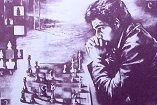


 Since
the book's initial release in Russian, Kasparov has spoken of this series as
almost a challenge to the chess world to find improvements and turn the books
into a definitive museum of classical chess.
Since
the book's initial release in Russian, Kasparov has spoken of this series as
almost a challenge to the chess world to find improvements and turn the books
into a definitive museum of classical chess.
This article by Garry Kasparov is the first of a whole series that will appear on this web site. In these articles the author presents and evaluates analysis that has been submitted to him after the publication of volume one of his book. It also contains discoveries that were made too late to be included in the book.
Remember that this is an ongoing process. With the participation of Kasparov, our analysts (human and silicon), and of course you, the reader, we will dig deeply into every game in the book.
As was anticipated, the first volume of My Great Predecessors provoked a great number of diverse comments in the press. Some analytical mistakes were also discovered. ‘Which is not surprising with such a wide-ranging coverage of history. But this is nothing terrible!’, writes grandmaster Igor Zaitsev in the chess magazine 64 (2003 No.6). ‘For me analytical sterility has always been virtually a synonym of inertia. Mistakes are both inevitable, and excusable – much more important is a lively reaction by the readers, a desire to discuss, and a spark of general analytical interest, in this case in the classics. I would give credit to the author for this and would number it among the obvious virtues of the new book’.

Work on the book never ends – Kasparov in a hotel suite in New York
I make no secret of the fact that it is pleasant when defects unexpectedly turn into virtues. Nevertheless I consider it necessary to acquaint the reader with the most interesting and important corrections, made during the several months that have passed since the publication of Volume 1.

Inside cover of the Russian edition
We will begin with one of Anderssen’s famous games, a detailed analysis of which was published in an old article by Igor Zaitsev: ‘In the shadow of the ‘Evergreen’’ (64 1976 No.5).
Game 4 (pages 26–29):
A.Anderssen-J.Dufresne, Berlin 1852

There followed the inspired 19 Rad1!? Qxf3? 20 Rxe7+! Nxe7!? (20...Kd8 21 Rxd7+! Kc8! 22 Rd8+! Kxd8 23 Be2+! etc. is more prosaic) 21 Qxd7+!! Kxd7 22 Bf5++ Ke8 (22…Kc6 23 Bd7 mate) 23 Bd7+ Kf8 24 Bxe7 mate!
19...Rxg2+? 20 Kxg2 Ne5 21 Qxd7+! would also have lost, but 19...Rg4! (Lipke) was much stronger. Now after 20 c4?, instead of 20...Rf4? 21 Bg6! (Hoppe, Heckner) or 21 Qb5, winning (Neishtadt), 20...Bd4!? with the threat of …Rxg2+ (Zaitsev) is not bad, but, in my opinion, the immediate 20...Rxg2+! is even better: 21 Kxg2 Qg4+ 22 Kf1 Qxf3 23 c5 (Zaitsev’s move; 23 Rxe7+ Nxe7 24 Qxd7+ Kxd7 25 Bf5+ Ke8 26 Bd7+ Kf8 and wins) 23...Qh3+! 24 Kg1 (24 Ke2 Ba5 25 Bb5 Nd4+!) 24...Ne5! with a decisive attack. More consideration should be given to 20 Re4!? Rxe4 21 Qxe4 d6 22 Re1! Qg6! and Black’s defences hold.
The main line is 20 Bc4 Qf5! 21 Rxd7 and here, fearing the variation 21...Kxd7 22 Ne5+ Kc8 23 Nxg4 Nd5 24 Qd1 Nxf6! (24...Nd8? 25 Bd3!) 25 Bd3! (although I do not share these fears: 25…Qxg4 26 Qxg4+ Nxg4 27 Bf5+ Kd8 28 Rd1+ Nd4 29 Bxg4 Bd5 30 cxd4 Bxa2 with equality), Zaitsev suggested 21...Rxg2+!? 22 Kxg2 Qg4+ 23 Kf1 Qh3+! 24 Ke2 Qxd7 25 fxe7 (or 25 Bxe7 Nd4+!) 25...Nd4+ 26 Nxd4 Qxa4 27 Bb5+ Qxb5+ 28 Nxb5 Ba6 29 c4 c6 30 Rg1 Kd7 31 Rd1+ Ke8 32 Nd6+ Kxe7 with a draw.
Then he tried to improve White’s play with 21 Rd2, but he himself parried it with the thematic move 21...Bd4!.
In addition Zaitsev found that after 19 Rad1 good was 19...Bd4! 20 cxd4 (20 Nxd4 Rxg2+! 21 Kxg2 Nxd4+) 20...Qxf3 21 Be4 Rxg2+ 22 Kh1 Rxh2++! 23 Kxh2 Qxf2+ 24 Kh3 Qxf6 with a draw.
It only remained to check once again Lasker’s recommendation 19 Be4!?.

Analysis diagram
In Volume 1 I gave the variation 19…Qh3! 20 g3 Rxg3+ 21 hxg3 Qxg3+ 22 Kh1 Bxf2 23 Bxe7! (23 Re2? Nd4!!) 23…Qh3+! 24 Nh2 Bxe1 25 Rxe1 Qh4! 26 Qd1! Nxe7 27 Bxb7 Qxf6 28 Qg4 ‘with the initiative’.
It turns out that this position had been studied some time ago by Murey and Fridstein (in 64, 1975 No.38) and after them also by Zaitsev, who thought that after 28…Kd8! White has nothing real and that better is 28 Bd5!? Qxc3 (28...Rb6? 29 Qh5!; less clear is 28...Rb2 29 Qh5 c6 30 Ng4 Qf4) 29 Qe2 (29 Bxf7+? Kxf7 30 Qh5+ Kg8! with a draw) 29...Qb4 (29...Qc5?! 30 Qe5!) 30 Ng4 (30 a3?! Qd6!) 30...Kd8 31 Qe5! c6 (31...Qxg4? 32 Qxe7+) 32 a3! Qxg4 (32...f6? 33 Nxf6 Qh4+ 34 Kg1 and wins) 33 Qxb8+ Nc8 34 Qe5! Qh4+ 35 Kg1 cxd5 36 Qe8+ Kc7 37 Rc1+ Kd6 38 Rxc8. ‘Apparently 30…Kf8! is more accurate. In short, a vicious circle arises, where it is hard to find a draw, but, in view of the limited material, even harder to demonstrate a win…’
Thus 19 Be4 was after all somewhat stronger than 19 Rad1. On the other hand, the rook move brought White an instantaneous and unforgettable win!
If you have any comments on Kasparov's analysis please send them to us. Your remarks and analysis will be scanned by GM Karsten Müller, who will pass the most interesting contributions on to Garry Kasparov for evaluation. We will publish our conclusions on these pages.